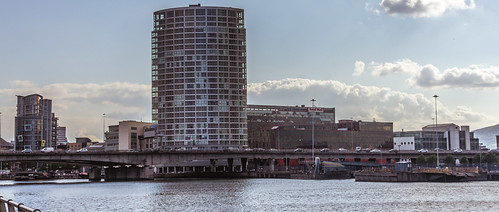In March celebrations of the 100th anniversary of the launch of RMS Titanic began with the opening of a major photographic exhibition at Belfast City Hall
As you can see from my photographs the exhibition focused on the construction of the ship through the lens of R J Welch, the official photographer for Harland and Wolff.
The date of the opening of the exhibition was significant, as it coincided with the anniversary of the laying of Titanic's keel, on 31 March 1909. As well as displaying photographs of the ship itself, the exhibition gave an insight into life at the Harland and Wolff shipyard and in Belfast more generally in 1911.
To some people it may appear rather strange to celebrate the launching of a ship that sank on its maiden voyage but as far as the people of Belfast are concerned they delivered a first class ship to a bunch of idiots who managed to sink it by ramming it into a huge iceberg.
Saturday, December 22, 2012
The 'Titanic 100' exhibition - Belfast City Hall.
Belfast - Titanic Boat Tours
During my visit to Belfast I met an old local gentleman who was highly amused by the fact that "Belfast's only claim to fame was a really big ship that did not even complete its maiden voyage".
Titanic was conceived, designed, built and launched in Belfast and... as they proudly say locally "She was alright when she left here!!!"
Belfast - Titanic Boat Tours
Scheduled guided Titanic tours take in the historic Harland & Wolff shipyards and the famous Titanic sites around Belfast Harbour. Although many of the riverside Harland & Wolff sheds were demolished in early 2002 and those sites/sights are now gone, their demolition has actually provided a much better view of the Titanic slipways which were previously hidden by these same sheds.
The harbour area itself has always been a romantic and mysterious place, full of interesting sights, sounds and history, an exciting place which reeks of adventure and far off places! As a busy working port, most of it has been inaccessible to the public for many years unless you were employed in the shipping or shipbuilding industries, or were a passenger aboard an incoming or outgoing ferry or liner. This tour is a unique opportunity to experience all those exciting travel urges that seem to grip your senses in such a place!
Titanic tours depart from the Jetty 2 beyond the sculpture of the 'Big Fish'.
Titanic Memorial, Belfast City Hall
The Titanic Memorial in Belfast was erected to commemorate the lives lost in the sinking of the RMS Titanic on 15 April 1912. It was funded by contributions from the public, shipyard workers and victims' families, and was dedicated in June 1920. It is located on Donegall Square in central Belfast in the grounds of Belfast City Hall.
The memorial presents an allegorical representation of the disaster in the form of a female personification of Death or Fate holding a laurel wreath over the head of a drowned sailor raised above the waves by a pair of mermaids. It has been used as the site of annual commemorations of the Titanic disaster.
For a while it was obscured by the Belfast Wheel that was removed in April 2010. It is now the centrepiece of a small Titanic memorial garden that was opened on 15 April 2012, the centenary of the disaster. Together with the garden, it is the only memorial in the world to commemorate all of the victims of the Titanic, passengers and crew alike.
Titanic Belfast is an iconic six-floor building featuring nine interpretive galleries

Titanic Belfast is an iconic six-floor building featuring nine interpretive galleries, a photo by infomatique on Flickr.
Titanic Belfast is an iconic six-floor building featuring nine interpretive galleries. The building also houses temporary exhibits, a 1000-seater banqueting suite, education and community facilities, catering and retail space and a basement car park. Visitors will learn about the construction of RMS Titanic and the wide and rich story of Northern Ireland’s industrial and maritime heritage.
Supported by the Northern Ireland Executive, Titanic Belfast is a unique public / private partnership funded by the Northern Ireland Tourist Board, Belfast City Council, Belfast Harbour and Titanic Quarter Ltd. It is operated by Titanic Belfast Ltd and will be owned by the Titanic Foundation Ltd.
Titanic Belfast's nine interpretative and interactive galleries explore the sights, sounds, smells and stories of Titanic, as well as the city and people which made her. Visitors will journey - by foot and by rides - through:
• Boomtown Belfast
• The Arrol Gantry & Shipyard Ride
• The Launch
• The Fit Out
• The Maiden Voyage
• The Sinking
• The Aftermath
• Myths & Legends
• Titanic Beneath (including the Ocean Exploration Centre)
Titanic Belfast: Visitor Attraction And Monument To Belfast’s Maritime Heritage
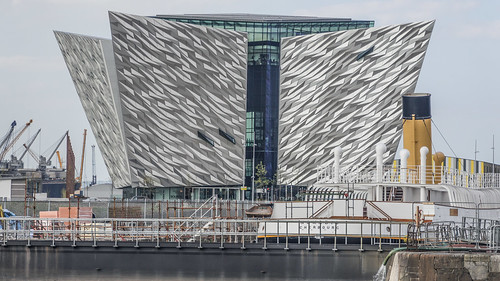
Titanic Belfast: Visitor Attraction And Monument To Belfast’s Maritime Heritage, a photo by infomatique on Flickr.
Titanic Belfast is a visitor attraction and a monument to Belfast’s maritime heritage on the site of the former Harland and Wolff shipyard in the city's Titanic Quarter. It tells the stories of the ill-fated RMS Titanic, which sank on her maiden voyage in 1912, and her sister ships RMS Olympic and HMHS Britannic. The building contains more than 12,000 square metres (130,000 sq ft) of floor space, most of which is occupied by a series of galleries, plus private function rooms and community facilities.
The building is located on Queen's Island, an area of land at the entrance of Belfast Lough which was reclaimed from the water in the mid-19th century. It was used for many years by the shipbuilders Harland and Wolff, who built huge slipways and graving docks to accommodate the simultaneous construction of Olympic and Titanic. The decline of shipbuilding in Belfast left much of the area derelict. Most of the disused structures on the island were demolished. A number of heritage features were given listed status, including the Olympic and Titanic slipways and graving docks, as well as the iconic Samson and Goliath cranes.
The derelict land was renamed the "Titanic Quarter" in 2001 and was earmarked by Harland & Wolff for redevelopment over a ten-year period. An area of 100 acres was subsequently bought by Fred Olsen at a cost of £46 million, with 23 more acres set aside for a science park. A further 78 acres was sold by Harland & Wolff in 2002 to be used for a new development including houses, hotels and entertainment amenities plus a maritime heritage museum and science centre.
In 2005, plans were announced to build a museum dedicated to Titanic to attract tourists to the area, with the aim of completing it by 2011 to mark the centenary of Titanic's launch.
A number of ideas were put forward for the attraction. Among ideas considered were reconstructing the massive steel gantry in which Titanic and Olympic were constructed, or building an illuminated wire frame outline of Titanic in the dock in which she was fitted out. In June 2008, details of the £64 million scheme – known then as "Titanic Dock" – were announced.
Northern Ireland's Tourism Minister, Arlene Foster, announced that the Northern Ireland Executive would provide 50 per cent of the attraction's funding through the Northern Ireland Tourist Board, with the remaining 50 per cent coming from the private sector, in the shape of Titanic Quarter Ltd and the Belfast Harbour Commissioners. Additional funding was pledged by Belfast City Council. The task of creating the visitor attraction was taken on by the Titanic Foundation, a charity which aims to "educate people on Belfast's social, historical, industrial and maritime heritage through the story of the Titanic".
The building, now known as Titanic Belfast, is expected to attract 400,000 visitors annually, of whom between 130,000–165,000 would come from outside Northern Ireland. It is intended that it will serve a similar function to that of the Guggenheim Museum Bilbao, designed by Frank Gehry, as a focus for the regeneration of the city. It forms part of the Titanic Signature Project to regenerate Titanic–related heritage sites in the Titanic Quarter, including the disused headquarters and drawing offices of Harland & Wolff, the SS Nomadic – the last surviving White Star Line ship – and Hamilton Dock, Titanic's dock and pump house and the Titanic and Olympic slipways.
In front of the building is Titanica, a sculpture by Rowan Gillespie depicting a diving female figure. Made of bronze, it is mounted on a brass base, evoking the design of figureheads on ships' prows, and is meant to represent hope and positivity. The figure was dedicated by representatives of the Anglican, Catholic, Methodist and Presbyterian churches on 27 March 2012, a few days before the opening of Titanic Belfast
Friday, December 21, 2012
Culture of Belfast
Belfast's population is evenly split between its Protestant and Catholic residents. These two distinct cultural communities have both contributed significantly to the city's culture.
Throughout the Troubles, Belfast artists continued to express themselves through poetry, art and music. In the period since the Good Friday Agreement in 1998, Belfast has begun a social, economic and cultural transformation giving it a growing international cultural reputation.
In 2003, Belfast had an unsuccessful bid for the 2008 European Capital of Culture. The bid was run by an independent company, Imagine Belfast, who boasted that it would "make Belfast the meeting place of Europe's legends, where the meaning of history and belief find a home and a sanctuary from caricature, parody and oblivion."
According to The Guardian the bid may have been undermined by the city's history and volatile politics.
In 2004–05, art and cultural events in Belfast were attended by 1.8 million people (400,000 more than the previous year). The same year, 80,000 people participated in culture and arts activities, twice as many as in 2003–04. A combination of relative peace, international investment and an active promotion of arts and culture is attracting more tourists to Belfast than ever before. In 2004–05, 5.9 million people visited Belfast, a 10% increase from the previous year, and spent £262.5 million.
Belfast: The Name
The name Belfast is derived from the Irish Béal Feirsde, which was later spelled Béal Feirste.The word béal means "mouth" or "rivermouth" while feirsde/feirste is the genitive singular of fearsaid and refers to a sandbar or tidal ford across a river's mouth.The name would thus translate literally as "(river) mouth of the sandbar" or "(river) mouth of the ford". This sandbar was formed at the confluence of two rivers at what is now Donegall Quay: the Lagan, which flows into Belfast Lough, and its tributary the Farset. This area was the hub around which the original settlement developed. The Irish name Béal Feirste is shared by a townland in County Mayo, whose name has been anglicised as Belfarsad.
An alternative interpretation of the name is "mouth of [the river] of the sandbar", an allusion to the River Farset, which flows into the Lagan where the sandbar was located. This interpretation was favoured by Edmund Hogan and John O'Donovan. It seems clear, however, that the river itself was also named after the tidal crossing.
In Ulster Scots the name of the city is Bilfawst or Bilfaust, although "Belfast" is also used.
Belfast (from Irish: Béal Feirste, meaning "mouth of the sandbanks") is the capital of, and largest city in, Northern Ireland.
Belfast (from Irish: Béal Feirste, meaning "mouth of the sandbanks") is the capital of, and largest city in, Northern Ireland.
Most of Belfast is in County Antrim, but parts of east and south Belfast are in County Down. It is on the flood plain of the River Lagan.
By population, it is the fourteenth largest city in the United Kingdom and second largest on the island of Ireland. It is the seat of the devolved government and legislative Northern Ireland Assembly.
The city of Belfast has a population of 281,000 and lies at the heart of the Belfast urban area, which has a population of 579,276. The Larger Urban Zone, as defined by the European Union, has a total population 641,638.
Belfast was granted city status in 1888.
Historically, Belfast has been a centre for the Irish linen industry (earning the nickname "Linenopolis"), tobacco production, rope-making and shipbuilding: the city's main shipbuilders, Harland and Wolff, which built the well-known RMS Titanic, propelled Belfast on to the global stage in the early 20th century as the biggest and most productive shipyard in the world. Belfast played a key role in the Industrial Revolution, establishing its place as a global industrial centre until the latter half of the 20th century. Industrialisation and the inward migration it brought made Belfast, if briefly, the biggest city in Ireland at the turn of the 20th century and the city's industrial and economic success was cited by Ulster unionist opponents of Home Rule as a reason why Ireland should shun devolution and later why Ulster in particular would fight to resist it.
Today, Belfast remains a centre for industry, as well as the arts, higher education and business, a legal centre, and is the economic engine of Northern Ireland. The city suffered greatly during the period of conflict called the Troubles, but latterly has undergone a sustained period of calm, free from the intense political violence of former years, and substantial economic and commercial growth. Belfast city centre has undergone considerable expansion and regeneration in recent years, notably around Victoria Square.
Belfast is served by two airports: George Best Belfast City Airport in the city, and Belfast International Airport 15 miles (24 km) west of the city. Belfast is also a major port, with commercial and industrial docks dominating the Belfast Lough shoreline, including the famous Harland and Wolff shipyard. Belfast is a constituent city of the Dublin-Belfast corridor, which has a population of three million, or half the total population of the island of Ireland.
Tuesday, December 11, 2012
National Geographic Readers: Titanic
Raymond Weil Women's 9440-STS-97081 Parsifal Two-Tone Mother-Of-Pearl Diamond Dial Watch
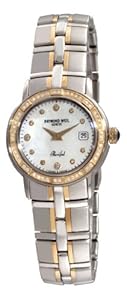
Raymond Weil watches integrate art and style with technical know-how, resulting in practical and elegant timepieces. This elegant two-tone timepiece displays a mother of pearl dial with diamond hour markers, a date, and a bezel set with quality diamonds.
Product Description: Two-tone stainless steel and gold case with a two-tone stainless steel and gold bracelet. Fixed stainless steel and gold bezel set with 48 diamonds. Mother of pearl dial with gold-tone hands and diamond hour markers. Minute markers around the outer rim. Date displays at the 3 o'clock position. Quartz movement. Scratch resistant sapphire crystal. Push in crown. Screw down case back. Case diameter: 27.0 mm. Case thickness: 7.3 mm. Push button deployment clasp. Water resistant at 100 meters/ 330 feet. Functions: hours, minutes, seconds, date. Raymond Weil Parsifal Ladies Watch 9440-STS-97081.

Wednesday, December 5, 2012
The Obel Tower is a skyscraper in Belfast, Northern Ireland.
The Obel Tower is a skyscraper in Belfast, Northern Ireland.
Update - 5th. December 2012:
[ --- When I visited Belfast I was a bit surprised by the amount of unoccupied commercial property so I was not surprised to read that the tallest building on the island of Ireland had been repossessed.
The 85m-high Obel Tower in Belfast was built at the height of the Irish property boom, but administrators have been called in because its owners owe the bank millions. ---]
Costing £60 million and measuring 85 metres (279 ft) in height, the tower dominates the Belfast skyline. On completion it overtook the previous tallest skyscraper in Ireland, Windsor House (80 m), also in Belfast. Developed by the Karl Marx Group, the Obel Tower is located on Donegall Quay on the River Lagan beside the Lagan Weir.
The tower contains 233 apartments. The first 182 apartments released in March 2005, priced from £100,000 to £475,000 were reserved off plan within 48 hours.
Construction work on phase one of the project, the foundations and 2 storey basement carpark, began in January 2006. In mid-2007 construction work on the site ceased, and all of the construction equipment was removed; construction then recommenced on 17 June 2008.
Planning permission was granted in January 2008 for an extra two floors to be added to the tower to cater for further demand in apartment space. The anticipated completion date was originally summer 2010; however, owing to the construction moratorium the building was not completed until spring 2011. These extra floors will bring the overall height up from 80.5 metres to 85 metres.
In April 2011 it was announced that London law firm Allen & Overy was to rent all of the available office space at the Obel.
In October 2011 local catering firm Mount Charles opened its second 'Fed and Watered' branded cafe in one of the retail units on the ground floor.


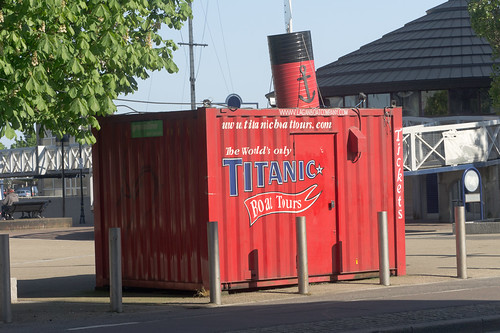
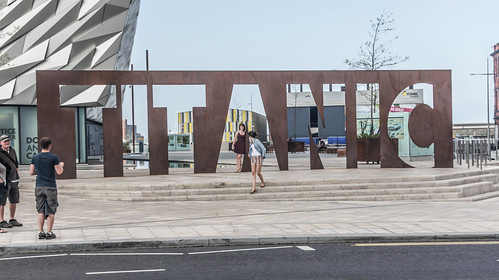
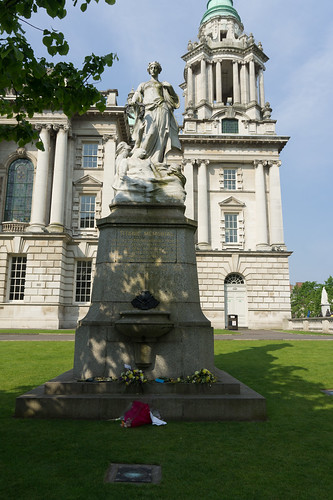

.svg/195px-Belfast_Coat_of_Arms_(Partial).svg.png)

